Report
DECEMBER UPDATE: A Tale of Two Democracies
The Voting Rights Lab made critical updates to its report, A Tale of Two Democracies, first released in June and updated in September, demonstrating how a wave of state legislation on voting rights and election administration is transforming our democracy, creating a new fault line between states strengthening our democracy and those restricting it. The latest update reflects the passing of pro-voter legislation in our nation’s largest state, California.
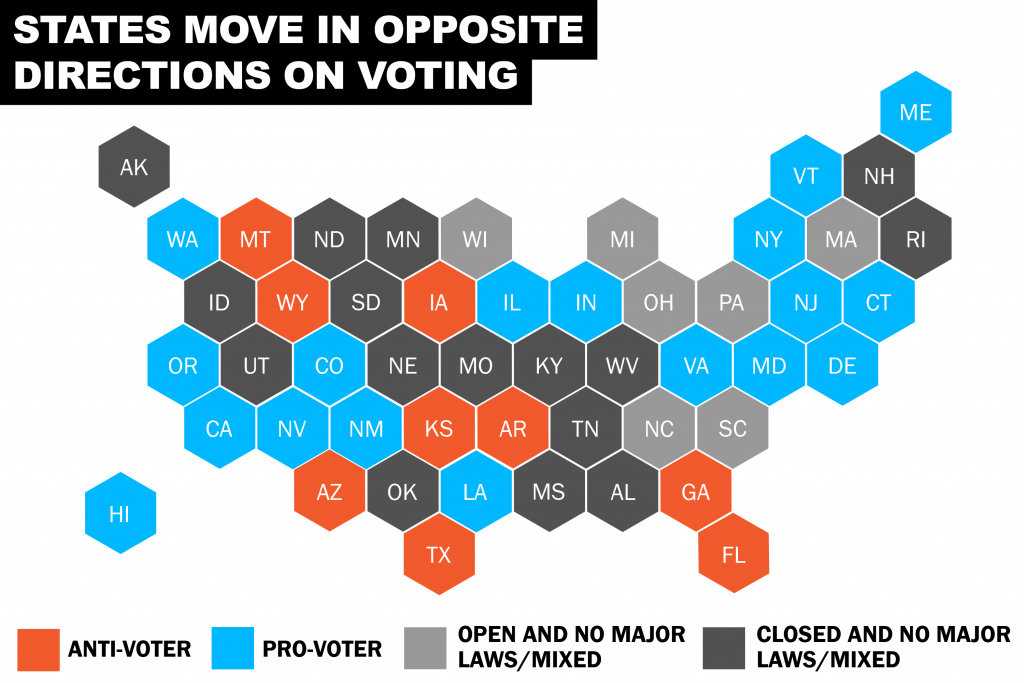
As of December 2, 2021, Voting Rights Lab has tracked 2,776 elections-related bills and 275 of those bills are now law in a total of 45 states. Of those bills enacted 109 are pro-voter, 47 are anti-voter, 27 are neutral, and 92 are mixed or unclear.
By our counts, which are updated regularly with the Voting Rights Lab State Voting Rights Tracker:
- 27 states have enacted legislation to expand and improve mail voting, while 13 states have enacted legislation restricting it;
- 20 states have enacted legislation improving voter registration, while 5 states have imposed new registration barriers;
- 15 states have enacted legislation shifting election authority, which in many cases could make the administration of elections more partisan;
- 15 states have created, expanded, or improved in-person early voting, while 1 state has restricted it;
- 14 states have created or expanded election-related crimes with potentially suppressive effects;
- 9 states have allowed election officials to begin processing mail ballots earlier, while 0 states have cut back pre-processing time;
- 7 states have imposed new or tougher voter ID laws, while 2 states have taken action to make their voter ID laws less restrictive;
- 7 states created or codified processes to notify voters of problems with their ballots and provide an opportunity to resolve the issue, while 0 states have rolled these processes back;
- 8 states passed laws to create, facilitate, or improve the accessibility of ballot tracking tools for voters (including one state that urged the implementation of such a system), while 0 states have done the reverse; and
- 8 states have expanded voting eligibility for or improved access for citizens with past felony convictions (or have paved the way for voters to approve such a law), while 0 states have done the reverse.
Millions of Americans are affected by these laws. More than 40% of eligible voters (96 million) live in states that improved their laws this year, more than 23% (55 million) live in states that enacted restrictive laws this year, and 1 in 5 (47 million) are awaiting a final tally upon the conclusion of their state’s legislative session or special session.
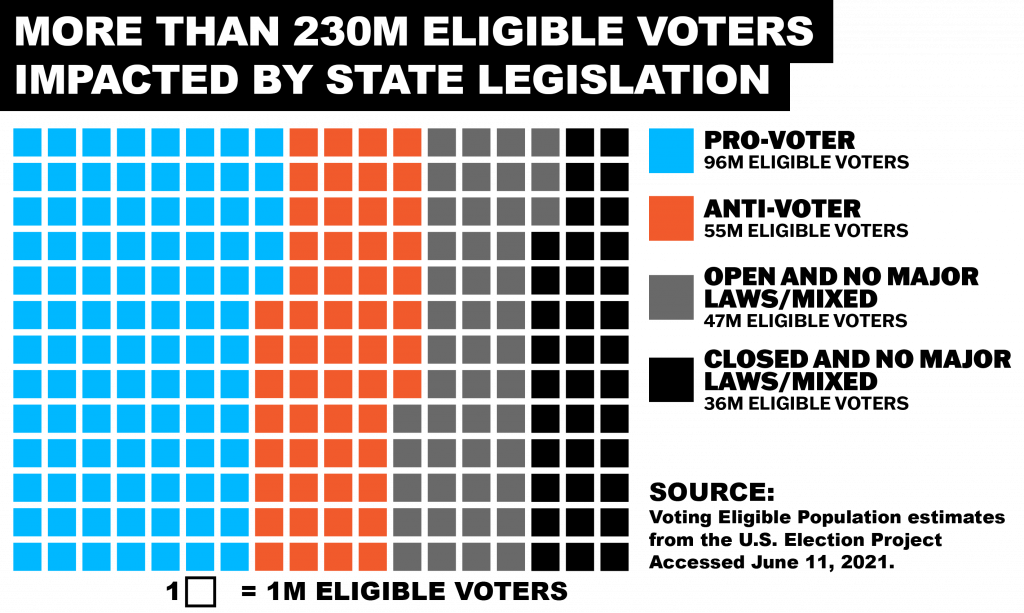
The updated analysis from Voting Rights Lab likely shows all we are going to see in 2021. Several key states – including Michigan, Wisconsin, Pennsylvania, and Ohio – are still in session, but we are unlikely to see major legislation passed before the end of the year.
Since our last report, California passed major pro-voter legislation. A.B. 37 makes California the seventh state in the country to proactively mail all voters a ballot prior to each election. The bill also gives voters more time to return their mail ballots and requires counties to provide electronic ballot tracking. S.B. 503 improves the process for matching signatures to validate mail ballots. Finally, A.B. 796 improves the process for automatic voter registration at the DMV.
Though they didn’t change categories, other states have passed elections legislation since our September report.
- North Carolina’s budget gave the speaker of the House and the president pro tempore of the Senate a new role in settling elections-related lawsuits. The bill also reduced the period of time a governor’s executive order during a state of emergency can be effective, making it difficult for the State Board of Elections to change election procedures in light of a public health emergency, as happened in 2020.
- Ohio passed a pro-voter bill enhancing transparency in the redistricting process.
- New York passed a bill to improve privacy for victims of domestic abuse who register to vote.
- Delaware passed a bill improving the redistricting process so that incarcerated individuals are counted in the place of their previous residence.
Of the states still in session, a few are scheduled to adjourn before the end of the year, including Pennsylvania (12/15).
Below is our updated report post from September, 2021.
SEPTEMBER UPDATE: The Divide in American Democracy Deepens
The Voting Rights Lab made critical updates to its June report demonstrating how a wave of state legislation on voting rights and election administration is transforming our democracy, creating a new fault line between states strengthening our democracy and those restricting it. The updated findings come as Texas further restricted its already stringent voting laws, year-round state legislatures return for the fall, and federal legislation continues to be debated in Congress.

As of September 7, 2021, Voting Rights Lab has tracked over 2,600 elections-related bills and 221 of those bills are now law in a total of 45 states. Of those bills enacted 102 are pro-voter, 41 are anti-voter, 26 are neutral, and 53 are mixed or unclear.
By our counts, which are updated in real-time at the Voting Rights Lab State Voting Rights Tracker:
- 27 states have enacted legislation to expand and improve mail voting, while 13 states have enacted legislation restricting it;
- 19 states have enacted legislation improving voter registration, while 5 states have imposed new registration barriers;
- 14 states have enacted legislation shifting election authority, which in many cases could make the administration of elections more partisan;
- 14 states have created, expanded, or improved in-person early voting, while 1 state has restricted it;
- 13 states have created election-related crimes with potentially suppressive effects;
- 11 states have allowed election officials to begin processing mail ballots earlier, while 0 states have cut back pre-processing time;
- 7 states have imposed new or tougher voter ID laws, while 2 states have taken action to make their voter ID laws less restrictive;
- 7 states created or codified processes to notify voters of problems with their ballots and provide an opportunity to resolve the issue, while 0 states have rolled these processes back;
- 7 states passed laws to create, facilitate, or improve the accessibility of ballot tracking tools for voters (including one state that urged the implementation of such a system), while 0 states have done the reverse; and
- 5 states have expanded voting eligibility for citizens with past felony convictions (or have paved the way for voters to approve such a law), while 0 states have done the reverse.
Millions of Americans are affected by their state lawmakers’ efforts to strengthen our democracy or those working to curtail it. Over one-quarter of eligible voters (70 million) live in states that improved their laws this year, nearly one-quarter (55 million) live in states that enacted restrictive laws this year, and 3 in 10 (75 million) are awaiting a final tally upon the conclusion of their state’s legislative session or special session.
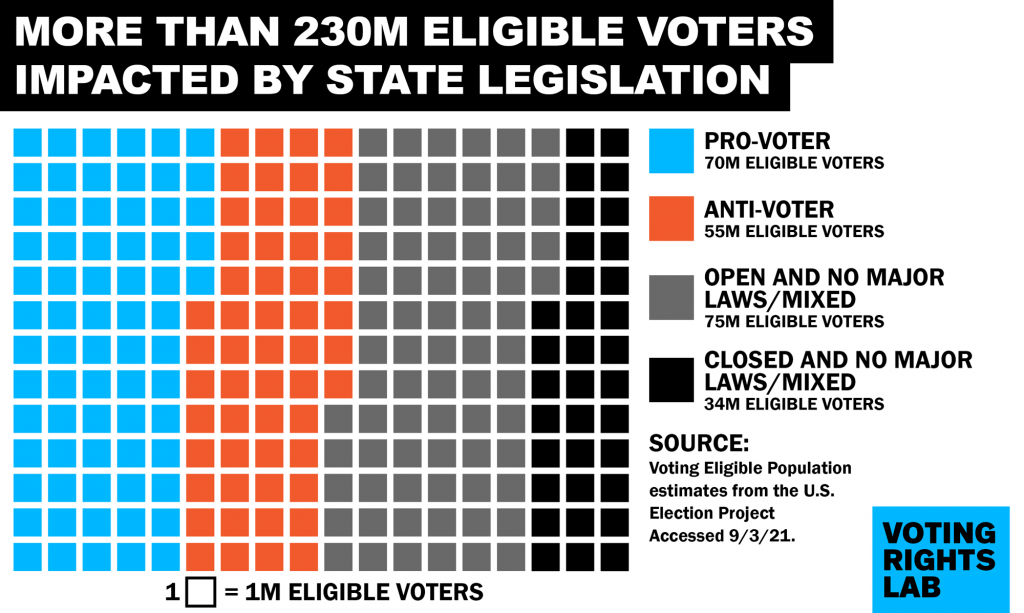
The updated analysis from Voting Rights Lab coincides with continued activity on the state-level and intensifying deliberation over two pieces of federal legislation, the For the People Act (H.R. 1/S. 1) and the John Lewis Voting Rights Act (H.R. 4). Key states to watch in the weeks ahead include:
- Ohio. Ohio’s legislature has yet to pass substantial election legislation during its year-long legislative session. The Republican-controlled legislature and Secretary of State Frank LaRose have proposed their legislative priorities via House Bill 294. The omnibus bill would allow voters to request an absentee ballot online and establish an automated voter registration and verification system, but it also includes a reduction in the number of days of early voting, new ID requirements for mail voting, strict limitations on the number and location of ballot drop boxes, and prohibitions on the provision of prepaid postage for mail ballot applications and ballots. The bill sponsor has indicated several amendments will be forthcoming, and this bill is expected to progress through the remainder of the year; however, legislators have also introduced House Bill 387, a far more restrictive elections bill containing provisions that would drastically limit voter access.
- Wisconsin. Wisconsin state lawmakers have introduced and advanced a cache of narrowly-focused bills designed to alter election procedures rather than a single omnibus like those already passed in Georgia and Florida. Governor Evers has vetoed several of these bills, including legislation that would have created stricter ID requirements for early voting and mail ballots, limited a voter’s ability to return a mail ballot by giving it to a third party, and increased the likelihood of a voter’s mail ballot being rejected for a minor defect. Bills that would limit voter’s ability to return a mail ballot using a drop box and create additional barriers for voters with disabilities have passed the first chamber.
- Michigan. Michigan lawmakers are taking a similar approach as those in Wisconsin by relying on bills dealing with individual issues rather than proposing a single election omnibus. Bills that would make ID requirements stricter for in-person voting and make verification of provisional ballots more difficult for voters have passed both chambers. A bill that would make ID requirements stricter for absent voter ballots has passed the Senate. Notably, Michigan Republicans have also recently launched a petition drive to change Michigan’s voter ID law to make it among the most strict in the nation.
A bill that has passed the House would allow local election officials to consolidate precincts and increase the numbers of voters serviced at each. Michigan lawmakers have also introduced bills that would close drop boxes prior to Election Day, prohibit election officials from providing prepaid postage for mail ballots, and allow parties and political organizations to designate challengers with greater authority to contest election processes, including the ability for challengers to videotape or photograph vote tabulation.
- Pennsylvania. Pennsylvania’s legislature has introduced a slew of elections bills that would eliminate no-excuse mail voting, create voter ID requirements for in-person voting, purge inactive voters from the voter registration list without notice, and shift election audit responsibilities from county election officials to the Auditor General’s office – with omnibus legislation likely to drop any moment after Governor Wolf vetoed H.B. 1300, an omnibus bill containing a mix of pro-voter and anti-voter provisions.
- North Carolina. North Carolina’s budget, as passed by both the House and the Senate, includes a number of attacks on North Carolina’s system of election administration, in particular the role of the North Carolina State Board of Elections (“NCSBE”). In addition to partisan power-grabs against the NCSBE, the budget includes funding to help put a law that is currently being challenged in court and could disenfranchise thousands of North Carolinians if it went into effect. Lawmakers continue to negotiate these and other provisions in the budget bill, with talks expected to stretch into fall. On September 8, the House Judiciary Committee heard Senate Bill 360, a standalone version of the attacks in the budget that would give legislators authority to block settlement of election-related lawsuits.
Click here to access the full, original report from June.
Notes
[1] This count omits TX H 3107, which appears in the link provided as a pro-voter early voting bill. With the recent passage of the omnibus TX S 1, Texas took significant steps to both expand and restrict early voting in different ways. As a result, we have excluded it from both categories.
Below is our original report post from June, 2021.
A Tale of Two Democracies: How the 2021 Wave of State Voting Laws Created a New American Fault Line
Below are excerpts from our new report. Click here to access the full report.
2021 has been a historic year for voting rights advocates, with both major gains and discouraging setbacks occurring in state legislatures across the country. This report outlines our observations from the state level so far this year, and what activity still remains to be seen.
The sheer volume of state legislative activity only tells one part of the story. What we are witnessing in real time across the country is a widening divide, whereby some states are working to expand participation in our democracy and strengthen our tradition of non-partisan elections administration, just as a significant number are working to curtail and undermine these objectives.
The growing fault line in the way states legislate voting is important not just on a theoretical level, but to voters of all stripes and all backgrounds. Take, for example, the issues of mail voting and early voting.
National data analyzed by Voting Rights Lab shows that early and mail voting accounted for nearly two-thirds of the total vote in the 2020 presidential election, and that these methods were broadly used by voters of all races and in both major parties, as well as independents. Mail and early voting were especially popular among veterans and active duty military, as well as voters age 55 and older. More than twice as many voters cast ballots by mail as on Election Day and roughly equal shares of voters cast early, in-person ballots as on Election Day. While 2020 was an anomalous year, the share of absentee and early voting has been steadily growing over time.
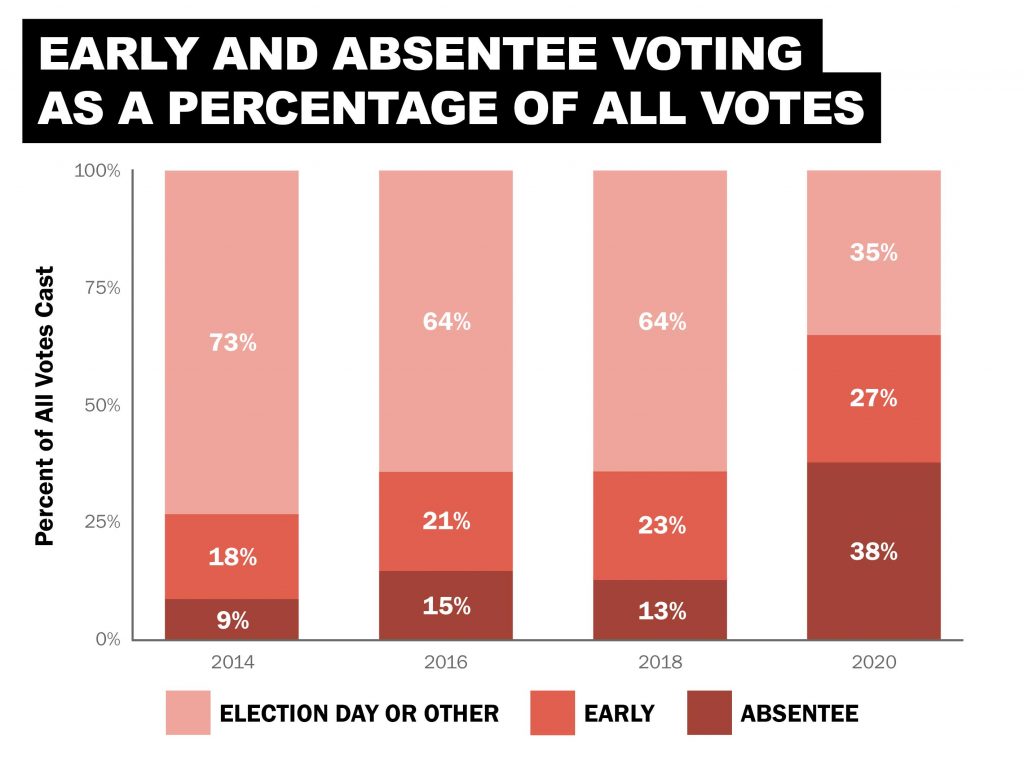
Whether a state is moving in the right or wrong direction can have significant implications for voters. For instance, the millions of voters living with disabilities tend to vote early or absentee because few in-person polling places are fully accessible.
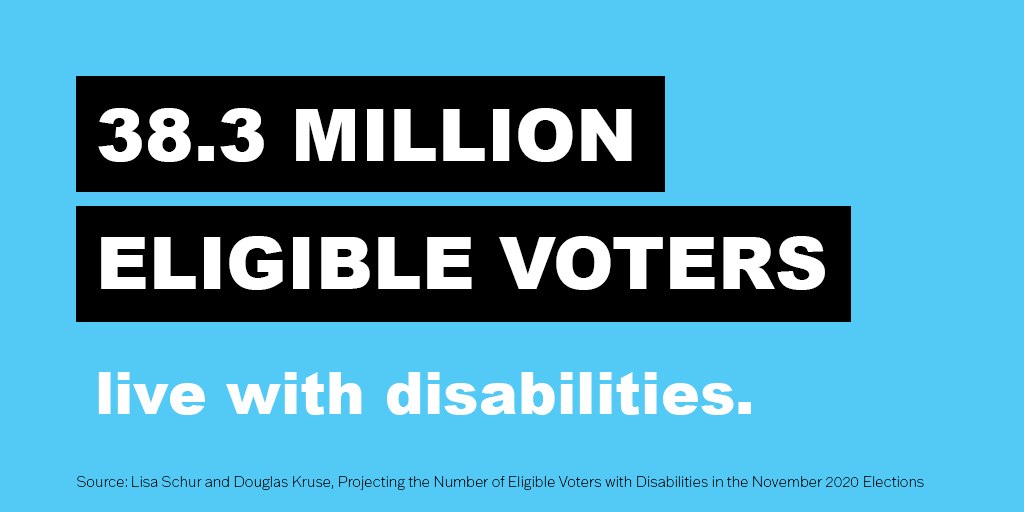
A Government Accountability Office investigation in 2016 found that only 17% of polling places were fully accessible for older voters with disabilities and 83% of polling places examined had at least one impediment to voting.1 This lack of access contributes to depressed turnout among voters with disabilities. Nationally, people with disabilities voted at a rate 7 percentage points lower than people without disabilities, despite the fact that people with disabilities demonstrate an interest in politics at a rate 11 percentage points higher than people without disabilities.2 Voters with disabilities are also the voters most often in need of third party assistance and, therefore, those put most at risk by new efforts to criminalize common forms of voting assistance.
It’s both the very personal ways in which pro-voter and anti-voter policies affect the public, especially those populations most historically oppressed and marginalized – as well as the intensity of the distrust in our system – that have resulted in so many entrenched, protracted state-level fights about voting rights. And unfortunately, there’s no sign of this abating.
Learn more in our complete report, A Tale of Two Democracies: How the 2021 Wave of State Voting Laws Created a New American Fault Line.
If you’d like to explore more of the graphics or browse related social media content, please check out our partner toolkit.
2021 Legislative Trends Summarized
PRO-VOTER TRENDS
- 9 states expanded in-person early voting
and only 1 has restricted it - 9 states are giving election officials more time to process ballots
with 0 states cutting back pre-processing time - 5 states passed ballot error notice and cure processes
and 0 states have rolled theirs back - 4 states expanded voting eligibility or access for citizens with past felony convictions
and 0 states have done the reverse - 4 states passed new or improved electronic ballot tracking laws
and 0 states have done the reverse
ANTI-VOTER TRENDS
- 11 states have passed new laws shifting election authority
with potentially chilling ramifications for non-partisan election administration in some of these places - 10 states have created election-related crimes
with potentially suppressive effects - 8 states made it more difficult to return ballots on behalf of voters
while 1 state made it easier - 6 states imposed new or more restrictive voter ID laws
while only 1 state took action to make its voter ID law more equitable
MIXED OUTCOMES
- 22 states expanded mail voting
while 11 have restricted it - 13 states improved voter registration
while 3 states imposed new registration barriers - 8 states expanded ballot drop off locations
while 4 states restricted them
Two Americas Left in the Wake
The sheer volume of state legislative activity only tells one part of the story. What we are witnessing in real time across the country is a widening divide, whereby some states are working to strengthen and expand participation in our democracy just as a significant number of states work to curtail it. Though many state legislatures are still in session – or reconvening in upcoming special sessions – the fault lines have begun to take shape.3

For every state that moves to restrict voting access, millions of voters are impacted. From Texas (18.7 million people eligible to vote4) to Florida (15.5 million) to Arizona (5 million), a growing sector of the American population will find its path to the ballot box obstructed. Increasingly, one’s ZIP code determines a citizen’s ability to exercise their constitutional right to vote.

Those most impacted by these mounting legislative obstacles are Americans who have historically been disenfranchised or blocked from casting a ballot. Black and brown people, Native Americans, voters with disabilities, veterans and members of the military, non-native English speakers, rural voters and low-income Americans – populations that have borne the brunt of disenfranchisement for generations and now face new, overwhelmingly onerous restrictions.
What we are left with is a disparity that both violates our country’s promise and echoes its history: Two Americas, two unequal populations. One group heard, one group silenced. A democracy divided.
Notes
[1] Voters With Disabilities: Observations on Polling Place Accessibility and Related Federal Guidance, 2017, U.S. Government Accountability Office, October 2017.
[2] Id, at 13.
[3] States in blue have enacted significant pro-voter legislation this session. Orange indicates states that have enacted significant anti-voter legislation this session. States in dark grey either enacted no major election legislation this session or the legislation they enacted was mixed in impact, not clearly categorizable as pro-voter or anti-voter on balance. Light grey indicates states that are either still open or have indicated that they will call a special session.
[4] The Voting Eligible Population estimates adjust the Voting Age Population by subtracting people ineligible to vote due to felony disenfranchisement laws and adding the estimated overseas voting population. Source: McDonald, Michael. 2020. U.S. Election Project. Accessed June 11, 2021 at http://www.electproject.org/2020g.